In Search of Lukara
Lillyan ratcliffe • december 27, 2022.
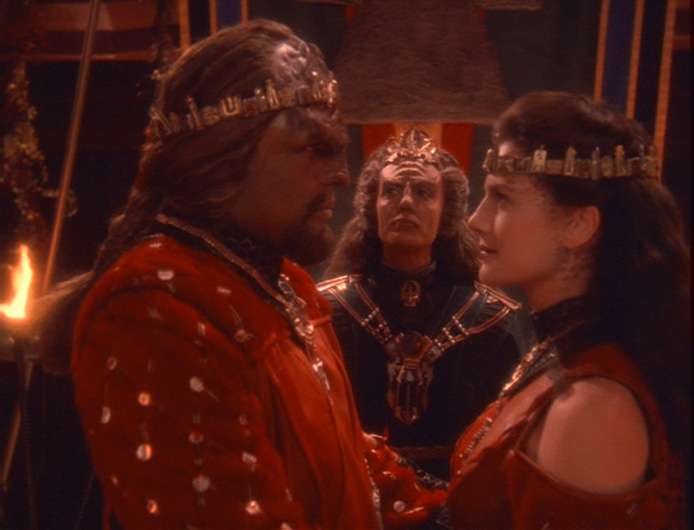
It is important to note that even though Lukara is mentioned several times throughout Trek, it is usually in reference to her relationship with Kahless. In the DS9 episode “Looking for Par’Mach In All The Wrong Places” their relationship is said to have started after they fought off 500 soldiers attacking a city after the entire city garrison fled. The two were later married and were attacked by the same enemy forces shortly thereafter. Nothing about Lukara’s life prior to or after Kahless is ever discussed on screen whereas many of Kahless’ achievements are mentioned without a connection to Lukara.
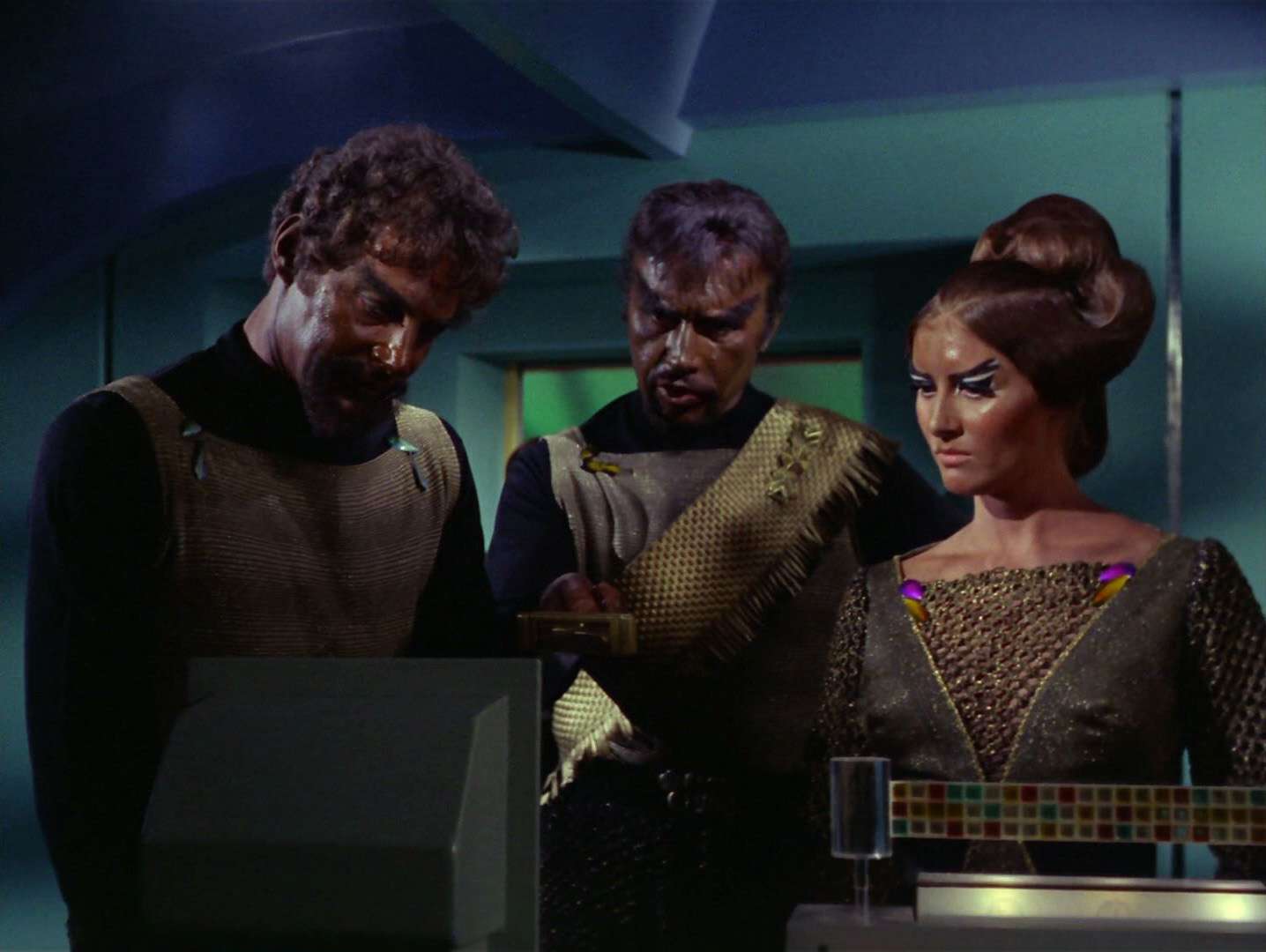
Klingon women were portrayed as strong and nearly equal to their male counterparts, even in The Original Series . Mara, the only Klingon woman to appear in TOS , is shown throughout her only appearance, in the episode “Day of the Dove” as a very intelligent, capable science officer who convinces her husband and captain, Kang, that an outside force is influencing both crews and that their crew needed to work with the Enterprise crew to defeat the alien controlling them. While the actress is wearing some very regrettable brownface – which adds an uncomfortable layer of colonialism to her fear of being assaulted or raped by the Enterprise crew – Mara comes across as a confident and rational Klingon compared to Kang, whose distrust of the Federation could have hurt both crews had Mara not convinced him to work with Kirk. Mara’s characterization set up future characterizations of Klingon women, including two of the most important Klingon women in Trek history, Lursa and B’Etor, who appeared in The Next Generation and Deep Space 9 several times as impressively ruthless and cunning warriors determined to grab power for the House of Duras.
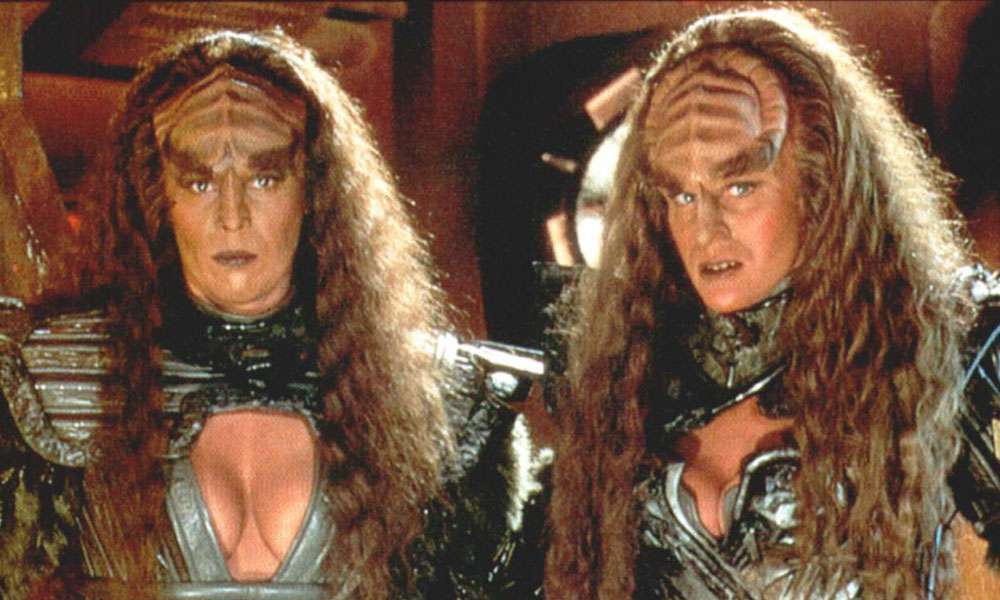
The sisters Lursa and B’Etor first appear in The Next Generation episode “Redemption,” where they try to put their illegitimate nephew, Toral, forward in place of Gowron to head the Klingon High Council. Previous episodes with their brother and Toral’s father, Duras, reveal that their family does not uphold honor and have used underhanded tactics to claim power behind the scenes of the council. Gowron even comments how deep their power is – to the point their family were one of the main forces behind the Klingon Civil War that killed Worf’s father Mogh and passed the dishonor onto House of Mogh – and how loyal the other members of the council are to the House of Duras.
Even though women cannot sit on the Klingon High Council unless there is no male heir to their house, the sisters plan to use Toral as their puppet, not-so-secretly in power behind him. Although Picard and Worf help prevent this, both sisters prove how ruthless they are. B’Etor attempts to seduce Picard and Worf proves how far from honor the sisters have fallen – they will use anything they can to grab power, including themselves. In their further appearances, Lursa and B’Etor are found to be selling weapons to Bajoran terrorists among other dishonorable acts, constantly threatening the objectives of Picard and Sisko and even the Federation itself. The reveal that Lursa is pregnant issues in the possibility of her child carrying on their mother and aunt’s ruthlessness and extending the power of their house even further into Trek’s future. Would Lukara have discommended the sisters for this behavior yet admired their drive?
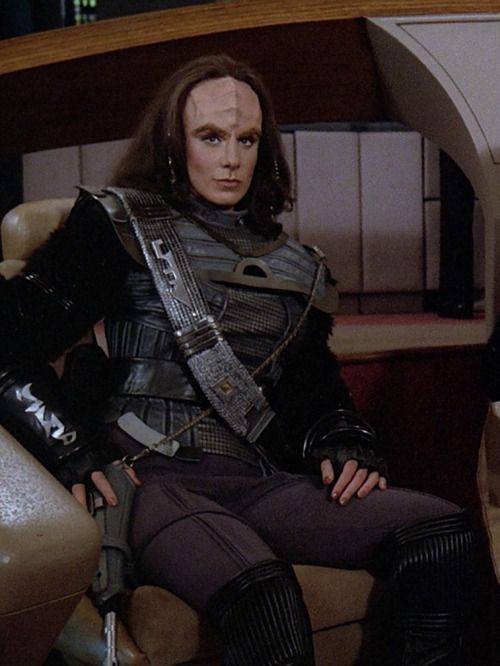
In contrast to the sisters, K’Ehleyr, the half-human half-Klingon ambassador, who helps uncover the plot against the House of Mogh and instructs Picard in Klingon rituals, allowing him to monitor Gowron, proves to be one of the most honorable Klingon women in TNG . Although she does not respect many Klingon cultural values, K’Ehleyr proves to have more honor than Lursa and B’Etor as she often works alongside Starfleet and the Federation to protect both them and the Klingon Empire. Her death even comes from her honor during her investigation into Gowron’s role in Worf’s discommendation (“Reunion”). When Gowron attempts to bribe her for her silence, including making the unprecedented move of offering her a seat on the Klingon High Council, K’Ehleyr refuses to bend. When she discovers proof that Duras was involved, Duras murders her to prevent her from bringing her evidence to the council or Picard.
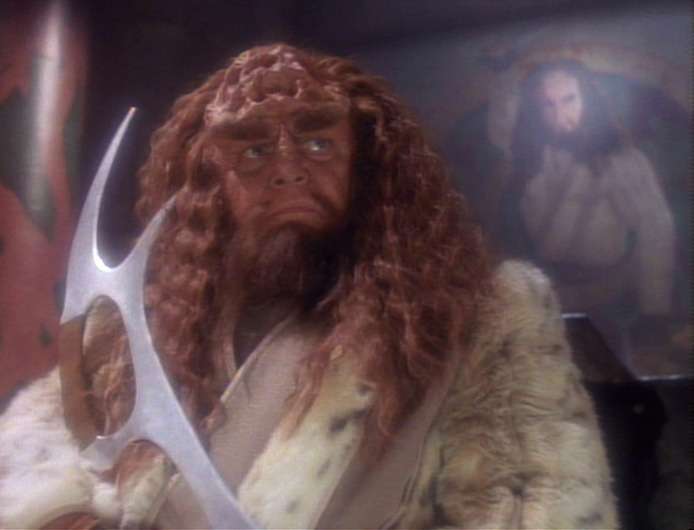
Throughout TNG , these Klingon women play vital roles, yet one of the most important Klingon episodes seems to forget Lukara exists. In the TNG episode “Rightful Heir” a cabal of scientists and priests create a clone of Kahless, the great warrior who slew the Klingon gods and created the code of honor that defined TNG Klingons, to guide the Klingons as a spiritual figurehead. Yet, for all of this effort the scientists and priests have put into creating a new Kahless, they did not create a Lukara who was right there beside him slaying the Klingon gods. Why would they overlook such a vital figure from their history? Unfortunately, even though the Kahless clone was present as a background character in several episodes of TNG following “Rightful Heir,” the potential of this plotline is never fulfilled nor are the hanging threads from this episode ever picked up in TNG or its successor, Deep Space Nine .
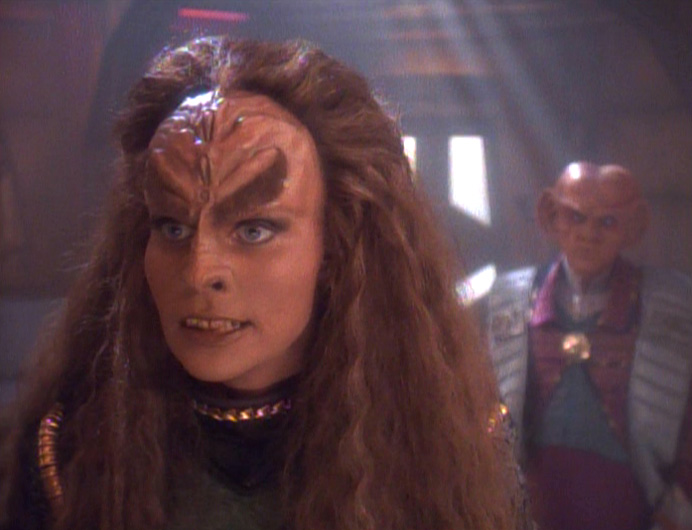
Deep Space Nine does feature the Duras sisters, but the other Klingon women featured in DS9 seem to embody the spirit of Lukara more than Lursa and B’Etor. Although Grilka, a minor character in two Quark heavy episodes (“The House of Quark” and “Looking for Par’Mach In All The Wrong Places”), originally seems to be a prop to develop Quark’s character, a further look reveals how cunning and honorable she is. When her husband, Kozak, dies by drunkenly falling on his own knife at Quark’s, a rival, D’Ghor, threatens Quark to lie about the manner of Kozak’s death so he can take over the House of Kozak. Refusing to let this happen, Grilka kidnaps Quark, performs a marriage ceremony between the two of them, and submits his claim as the new male head of house. Quark utilizes his business knowledge to uncover D’Ghor had schemed and manipulated various factors to claim the House of Kozak, since there was no male heir.
When confronted with the proof, D’Ghor prepares to battle Quark, yet when Quark refuses to fight, D’Ghor nearly kills Quark. This act solidifies Quark’s case, allowing Grilka to reclaim her house. While Grilka originally argued against Quark using the financial records to challenge D’Ghor, her utilization of D’Ghor’s own plot to take over her house reveals how cunning she is – since D’Ghor made Quark lie that Kozak died in honorable combat, Grilka was within her right to choose another husband to lead her house. She used honor to challenge D’Ghor’s scheming and since she agreed to let Quark examine the financial records, she was able to undermine D’Ghor and claim her house. This ability to align herself with others even when it pitted herself against her fellow Klingons recalls Mara’s role in “Day of the Dove.|
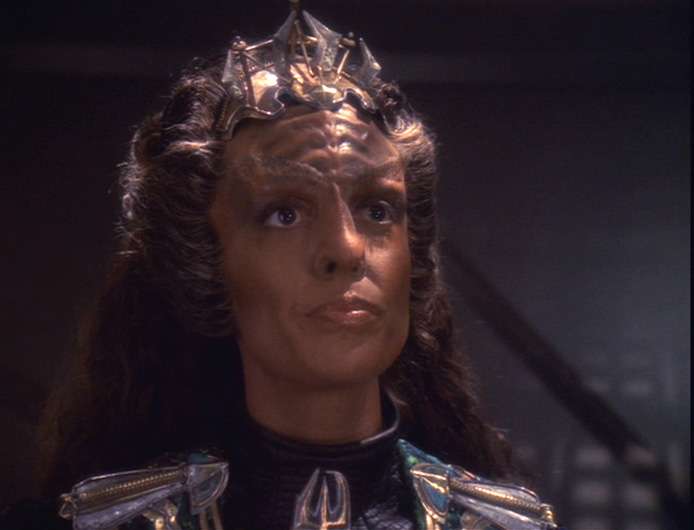
A wonderful opportunity to incorporate Lukara into the show was missed in the DS9 episode, “You Are Cordially Invited”. The episode focuses on Jadzia and Worf preparing for their wedding and the arrival of Sirella, the Lady of the House of Martok, at the station to approve Jadzia joining her house. The writing of the episode sadly sets Sirella and Jadzia as rivals with both refusing to reach a compromise until the very end. Sirella in particular suffers as she is written in the vein of the trope of a shrewish nag who immediately berates Martok when she arrives and is xenophobic to Jadzia from the outset.
Their conflict could easily have been addressed by having the wedding preparations included the two taking part in a holo-recreation of a famous battle where they fought alongside a holo-Lukara as a test of Jadzia’s battle skills and knowledge of Klingon history. Jadzia’s relationship with Worf had included sparring in the holosuites already and seeing her fight alongside Sirella could have allowed the two women to teach each other as well as learn from each other and Lukara herself, giving all three some positive characterization. The lack of the kind of flexibility we see with Mara and Grilka is a detriment to Sirella’s character.
Star Trek’s depiction of Klingons has evolved several times, coming to embody a culture based on honor and prowess in battle. Yet one of the women at the center of Klingon history, Lukara, has yet to be depicted in any of the series or movies. When contrasted with the Klingon women who have appeared in Trek, the lack of Lukara is very striking. She could provide an excellent glance into Klingon culture and history, yet she is still relegated to verbal mentions even when multiple Trek series are airing concurrently.

Post navigation
Leave a reply cancel reply.
Your email address will not be published. Required fields are marked *
- The Inventory
Everything You Need to Know About the Klingons, Star Trek 's Ever-Changing Space Warriors
Klingons are one of the most iconic Star Trek alien races. In 51 years they’ve evolved from deceptive villains to honorable allies—and now, with the arrival of Star Trek: Discovery this week, they’re becoming spiritual warriors once again, at odds with our heroes. Here’s everything you need to know about the past, present, and future of Qo’noS’s finest.
Related Content
From enemy, to ally, to enemy.
Klingons have been one of the most persistent elements of Star Trek . They made their debut on the very first season of the original show, and have since appeared on every spinoff series, including Discovery —and in most of the Trek movies, as well.
The Klingons first met by Kirk and his crew in “Errand of Mercy” back in 1967 were very different from the Klingons we know today, both in their physical appearance and in their characterization. Intended as a Soviet parallel to the Federation’s US, the original Klingons were treated as inferior to the Federation’s ideals in every manner. The Klingons were a crafty, savage, and warmongering race, morally corrupt and willing to do anything to get their way—especially if it meant getting the upper hand against the Federation, their long-time rivals in an interstellar cold war.
That nature uncomfortably played into their appearance as well. The original Klingons were given an incredibly Orientalist aesthetic, with white actors having their faces darkened with makeup to appear more alien, plus accented eyebrows highlighted with shoe polish and matching thin mustaches. To the modern eye, the look of original Klingons is deeply problematic, but at the time, it was a huge budget saver; one of the primary reasons the Klingons became such major recurring villains in the original series was that their makeup costs were much lower compared to the prosthetics needed for the Romulans.
After the Star Trek TV series came to an end, then found itself revived as a movie series in the ‘70s, there was finally a budget to make the Klingons appear truly alien—and with it came a complete overhaul of the race that changed their place in the franchise. Their new makeup work gave the Klingons long, flowing hair, sharpened teeth, and distinctive forehead ridges (more on those later), but Klingon culture was given an even greater shake-up. A new language was introduced to further emphasize the differences between the Klingon Empire and the Federation, and, taking inspiration from feudal Japan, Klingons became a species that valued honor above all else, holding strictly defined traditions around the art of war that formed the cornerstones of Klingon society.
Although original Trek creator Gene Roddenberry was hesitant to bring back old aliens when Star Trek returned to TV with The Next Generation , set a century after the original show, the Klingons ultimately became a fundamental part of the series in the form of Michael Dorn’s Worf, a Klingon member of Starfleet and one of the show’s primary characters. Representing a time period when the relationship between the Federation and the Klingon Empire had become relatively amicable, Worf became a lens for the audience to discover the new culture behind the Klingons first hinted at in the movies, examining both their dedication to martial prowess (with the introduction of iconic elements like the Bat’leth, the curved Klingon blade) and their spiritual side. Gone were the savages of the original series, instead replaced by a principled society of honorable warriors.
By the time of Voyager and Deep Space Nine (the furthest we’ve been into Star Trek ’s timeline on TV) the Klingons had become heroes. After a brief period of hostility the Klingons became crucial allies for the crew of Deep Space Nine and the Federation at large in DS9 's seasons-long war with the Dominion, while Voyager examined prejudices and acceptance of the Klingons within Starfleet through B’Elanna Torres, a half-human, half-Klingon engineer troubled by the pull between her two very different cultures.
Discovery , set a decade before the original show, mixes up the Star Trek timeline a bit. The Klingons are the primary antagonists of the series, with the Federation openly at war with them. However, the show portrays the Klingons as fans have come to know them: as an honorable warrior race —right down to the forehead ridges. Speaking of which...
The Fall and Rise of the Klingon Forehead
How the Klingons grew from the mustachioed, smooth-headed humanoids of the original series to the ridged aliens of The Original Motion Picture and beyond has been a canonical puzzle Star Trek fans have theorized and debate about for decades. There was never a reason provided for the difference in either the movies or The Next Generation —it was simply declared that these new aliens were still Klingons and that was that.
For years, the closest the series ever got to acknowledging the change was a one-off joke in the special Deep Space Nine anniversary episode “Trials and Tribble-ations,” which saw the crew sent back into the past to the events of the original series episode “The Trouble with Tribbles.” When asked by his colleagues why the Klingons of Kirk’s time looked so different to the Klingons they know of in the 24th century, Worf offers a brief but stern rebuttal: Klingons don’t talk about it with non-Klingons.
Fans finally got an explanation for the disparity between the two kinds of Klingons nearly 40 years after their first appearance thanks to Star Trek: Enterprise , which was set in the years before the formation of the Federation. A two-part story in the show’s fourth season revealed that Klingons have actually always had forehead ridges, but a virus accidentally unleashed on the Klingon homeworld when scientists tried to augment Klingons with human DNA caused victims to develop human physical characteristics, including smooth foreheads. A treatment for the virus was developed by Enterprise ’s resident medic, Dr. Phlox, but the physician theorized that it would take generations for Klingon children to be born with ridged foreheads again.
It remains to be seen whether Discovery , which features pre-original series Klingons with forehead ridges, will have something to say about the bizarre evolution of the feature, given its place in Star Trek ’s timeline. But we do know that the series will provide a biological reason for the ridges : they’re covered in extra-sensory receptors, to help Klingons detect and hunt their prey.
The Long Road to Sto’Vo’Kor
Although Klingons have been established as a warrior race from the beginning (honorable or otherwise), one major element of Klingon culture introduced in their post-original Trek appearances is an emphasis on spirituality, borrowing elements from familiar mythological cultures in our own past to turn the Klingons into quasi-warrior monks. The honor-bound nature of the Klingons has led to many instances of their culture clashing with that of the Federation through a love of rituals and remembrances, especially around the act of honoring the dead.
In the Klingon belief system, the body after death is an empty shell. The soul of a fallen Klingon goes to one of two places. If they lived an honorable life and fell in battle, they go to Sto’Vo’Kor, which is pretty much Klingon Valhalla, a heavenly plane of battles and feasting. If they were dishonored or didn’t die fighting, they go to Grethor, a fiery hellscape where their souls suffer for eternity—after the prerequisite journey on a barge through a river of death to Grethor’s gates, of course. Relatives of the deceased can perform honorable acts in their own lives to ensure their fallen relative’s soul goes to Sto’Vo’kor if they didn’t die in battle—which, in some cases, can include offering their own soul for torture in Grethor in their place, as B’Elanna attempted to do for her mother in the Voyager episode “ Barge of the Dead .”
Aside from their ritualized beliefs and honor codes, Klingon spirituality includes no gods, as legendary warriors killed them thousands of years ago. There is one important figure in Klingon religion, though: Kahless, who was the first ruler of the Klingon Empire and established its honor code. Weirdly enough, by the time of The Next Generation and beyond, the Empire was once again led by Kahless... except this time it was a lab-grown clone of the original, a slightly less intimidating figure and more of a figurehead for Klingon society than an actual ruler.
Talking Klingon
As Star Trek ’s portrayal of Klingon culture developed, so did the need to make the race feel alien beyond the makeup-drenched actors of the original show—and part of that was the development of a whole new language for Klingons to speak in. Originally devised by Scotty himself, James Doohan, and Motion Picture producer Jon Povill as part of the film’s wide-scale re-imagining of the Klingons, the Klingon language (sometimes referred to as Klingonese) as we know it today was really developed during the making of The Search for Spock by Dr. Marc Okrand.
Okrand expanded the handful of words created during The Motion Picture into a fully constructed language, and in 1985, he published The Klingon Dictionary. Originally intended as source material for writers and actors, the dictionary expanded on Klingon grammar, such as its unconventional object-verb-subject form. It also gave Klingon phrases for everything as menial as “Happy Birthday” (qoSlIj DatIvjaj) to insulting someone’s mother with the smoothness of their forehead (Hab SoSlI’ Quch!)
Okrand’s work on the Klingon language flourished, not just because of his own additions to it as Star Trek continued, but through the works of fans. Shortly after The Klingon Dictionary ’s release, fans started to learn and teach the rules Okrand had laid down, and groups like t he Klingon Language Institute started forming in the early ‘90s to study the entirely fictional language. In the years since, translations of famous texts have been made available in Klingon—from Bible passages, to the epic Gilgamesh , to Shakespearian plays (inspired by the line from Star Trek VI: The Undiscovered Country , “ You have not experienced Shakespeare until you have read him in the original Klingon ”), as well as an entire opera performed in the language , ‘u’ , all done by ardent fans.
Klingons are one of Star Trek ’s most enduring features—their reliable presence across 51 years of the franchise is as defining as their ability to change each time we meet them. Whether it’s in big ways or small, change is fundamental to the Klingons, from the mustachioed brutes of the original series, to the dominating, brutal, and alarmingly spiky armored hunters we’re about to meet in Star Trek: Discovery . No matter how many times they show up, it’s always guaranteed that there’s always going to be something new to learn about them.
Screen Rant
Star trek: discovery: who are the klingon matriarchs.
The latest episode introduced the matriarchs of the House of Mo'Kai. But what's their role in the Klingon Empire and their stake?
Warning: SPOILERS for Star Trek: Discovery Episode 4: “The Butcher's Knife Cares Not for the Lamb's Cry” ahead.
Four episodes in, Star Trek: Discovery is doing its best to reinvent the dilithium crystal while exploring some of the defining events in the Star Trek saga. One of the most potentially interesting aspects of the latest series is the curious (and wildly divergent ) history of the Klingon Empire. So far, the show’s already tapped into the allegorical vein, showing Klingon unifier T’Kuvma (Chris Obi) in search of political power by railing against the symbolic other, their potential assimilators, the Federation.
Although the Klingon's look differs dramatically from Star Trek: The Original Series and the motion picture eras, their ideology and even some of the names on the show (such as Kor) tie into their legacy. Traditionally limited in power and status, later series like Deep Space Nine and Enterprise explored women's struggle for political might in the Empire and their impact on the culture from behind the scenes. As a modern-era show, Discovery will also explore the role of women in the Klingon Empire, as well as their role in shaping it.
In Discovery 's fourth episode, poetically titled “The Butcher's Knife Cares Not for the Lamb's Cry”, the show adds yet another curious layer to Klingon lore: the matriarchs of House Mo’Kai. But who are they and what do they want?
Women in Klingon Culture
In the Klingon Empire, women were typically barred from serving on the High Council, although there were a few exceptions – such as Azetbur, who replaced her father, Chancellor Gorkon, after his death. Despite their lack of representation in public life, Klingon women held a great deal of sway within the Great Houses. At the same time, they couldn’t lead them or inherit property – although widowed matriarch Grilka reshaped things in the DS9 episode “The House of Quark.” Until the 24th century, though, it was also rare to see women in combat, and male warriors heavily outweighed their female counterparts on starship crews.
Nevertheless, some women, like Lursa and B'Etor on TNG , not only held power in their house but shaped the Empire with their efforts. Those with ties to humanity, such as Worf’s mate, K’Ehlor, and Lt. B'Elanna Torres on Voyager, escaped prescribed Klingon gender roles outside of the Empire. Of course, the Klingons may have been more egalitarian at one point in time, at least before they returned to the honorific ways most fans are familiar with.
On Discovery , as battle deck commander for T'Kumva's house, L’Rell (Mary Chieffo) is a key member. After his death, she also places herself in a unique position. By rescuing Voq (Javid Iqbal) from certain death, she saved the otherwise short-lived unification movement. In doing so, she also turns her back on a powerful ally, Kol (Kenneth Mitchell) from the House of Kor, in favor of an outcast and their glorious cause.
T’Kuvma's death might have tested her faith, but her actions indicate a continued belief in his mission of Klingon purity, honor, and concordance. Being Voq’s ally and lieutenant also comes with another benefit. She escapes the trappings of the political world, by which she's likely referring to the repression of Klingon women. Of course, as the daughter of two houses, L’Rell comes from a fairly unique position in the Klingon Empire as well. Nevertheless, the House of T'Kuvma, although a minor player, is scattered at present. So, she turns to the Great House of Mo'Kai.
House Mo’Kai and the Matriarchs
Although the full depth of L’Rell’s “matriarchs” remains cloudy, we can surmise several things from her exchange with Voq. First off, the House Mo’Kai (or mo’qay , in subtitles) – which may refer to a house Captain Janeway belonged to during a Hirogen holo-program on the Voyager episode "The Killing Game" – appears to have a strong female core. Since Klingon society is patriarchal, Mo’Kai could be unique in that. Even though represented by a man, Ujilli (played by Damon Runyan), who first appeared in the pilot, he could merely be a figurehead. L'Rell also refers to her mother’s house as a house of " watchers, ” “ deceivers ," and " weavers of lies. " Whether this is a derogatory slur aimed at a house ruled by women or an earned reputation for espionage is unclear, though.
While Klingon warriors depicted in the 24th century on DS9 or TNG valued honor above all else, the Klingons of TOS were portrayed as sneaky and underhanded, as well as combative. T’Kuvma’s quest to unify the great houses is clearly a reaction to, in part, a cultural decay he saw within the Empire. However, his efforts don’t seem to have a sweeping effect on their culture until Star Trek ’s film era – something also unsurprising given Kol’s duplicitous behavior (stealing Voq's followers). Assuming the treacherous Klingons of Kirk’s era are prevalent a shy ten years before it, the House of Mo’Kai may deserve their reputation as accomplished spies.
Either way, L’Rell’s strength and independence as a Klingon woman likely stems from these mysterious matriarchs. When she tells Voq he’ll need to sacrifice “ everything ,” she probably means he needs to reimagine himself as a Klingon to gain the acceptance, or at least the fealty, of the great houses. His faith the ways of a warrior might be appropriate for the battlefield, but he's a commander without an army at the moment. To regain his edge might require some re-education, with an emphasis on sabotage, manipulation, surveillance, and guerrilla tactics. Even though those concepts cut against the grain of “honorable” Klingon culture, they may be necessary to align the empire against the Federation.
Also, by submitting to the matriarchy, he’s forced to reject his antiquated notions about a woman’s place in Klingon society, something he clearly isn’t too concerned about – both due to his respect for L’Rell in general and his class status. As an outcast without a house, at least until T’Kuvma's defunct one, "everything" isn’t too great a cost.
Although they haven't been revealed officially, the matriarchs of the House of Mo’Kai seem to allude to the Wayward Sisters (or Three Witches) in Shakespeare’s Macbeth. In the play, they cook up “ double bubble toil and trouble ” for the doomed monarch, shaping events with their machinations. Similarly, if the matriarchs truly are a house of spies, they share a shadowy association and could tweak fate from behind the scenes.
Hopefully, Discovery will explore their role in the conflict in greater detail. At present, they appear to be the guiding hand behind Voq’s revenge and may even play a larger role in shaping the Klingon Empire. If so, it would be ironic if the macho, honor-bound culture gained prevalence thanks to the efforts of brilliant female spies. Much like the Sisters' designs for Macbeth, though, are the matriarchs of Mo'Kai able guides for Voq’s holy quest, or will they spell his eventual downfall?
Next: Star Trek: Discovery Ripper Origin & Navigator Explained
- Cast & crew
- User reviews
The Emissary
- Episode aired Jun 24, 1989

The Enterprise addresses the emergency of an old Klingon ship coming out of stasis and ready to fight the Federation. A half-Human/half Klingon emissary arrives to help, who once knew Worf i... Read all The Enterprise addresses the emergency of an old Klingon ship coming out of stasis and ready to fight the Federation. A half-Human/half Klingon emissary arrives to help, who once knew Worf intimately. The Enterprise addresses the emergency of an old Klingon ship coming out of stasis and ready to fight the Federation. A half-Human/half Klingon emissary arrives to help, who once knew Worf intimately.
- Gene Roddenberry
- Richard Manning
- Hans Beimler
- Patrick Stewart
- Jonathan Frakes
- LeVar Burton
- 16 User reviews
- 9 Critic reviews

- Captain Jean-Luc Picard

- Commander William Thomas 'Will' Riker

- Lieutenant Geordi La Forge

- Lieutenant Worf

- Counselor Deanna Troi

- Lieutenant Commander Data

- Wesley Crusher
- (credit only)

- Doctor Katherine Pulaski

- K'Ehleyr

- Capt. K'Temoc
- (as Lance Le Gault)

- Adm. Gromek

- Chief Miles O'Brien

- Ensign Clancy
- (as Anne Elizabeth Ramsey)

- Tactical Crewman
- (as Dietrich Bader)

- Enterprise Computer
- (uncredited)

- Skull-Faced Warrior
- Enterprise-D Ops Ensign
- All cast & crew
- Production, box office & more at IMDbPro
Did you know
- Trivia Suzie Plakson had previously appeared in The Schizoid Man (1989) as the Vulcan Dr. Selar.
- Goofs It was suggested as a goof that, when K'Ehleyr asks the computer to list the holodeck exercise programs, it shows the list and highlights Worf's program before she tells it to. What is incorrect here is that the Holodeck's computer interface does not stop on Worf's Calisthenics program before she tells it to. It stops when it is scrolling through the list of programs, and she tells it to "Hold" when it reaches his program. Then she reads it.
[the Enterprise approaches the T'Ong, a Klingon battle cruiser]
Lt. Commander Data : Sensors show life forms aboard, but I am unable to ascertain whether they are awake or dormant; however, their propulsion system is inactive, so I would hypothesize that the crew is asleep.
[the Klingon ship fires at them]
Lt. Commander Data : However, I could be in error.
- Connections Features Star Trek: The Motion Picture (1979)
- Soundtracks Star Trek: The Next Generation Main Title Composed by Jerry Goldsmith and Alexander Courage
User reviews 16
- Jun 9, 2021
- June 24, 1989 (United States)
- United States
- Official site
- Paramount Studios - 5555 Melrose Avenue, Hollywood, Los Angeles, California, USA (Studio)
- Paramount Television
- See more company credits at IMDbPro
Technical specs
- Runtime 45 minutes
- Dolby Digital
Related news
Contribute to this page.
- IMDb Answers: Help fill gaps in our data
- Learn more about contributing
More to explore

Recently viewed
- More to Explore
- Series & Movies
Published Sep 23, 2022
How Love Changed Our Favorite Klingon Worf
'Worf’s growth throughout the series explores questions of honor, pride and what it means to 'be a man.''
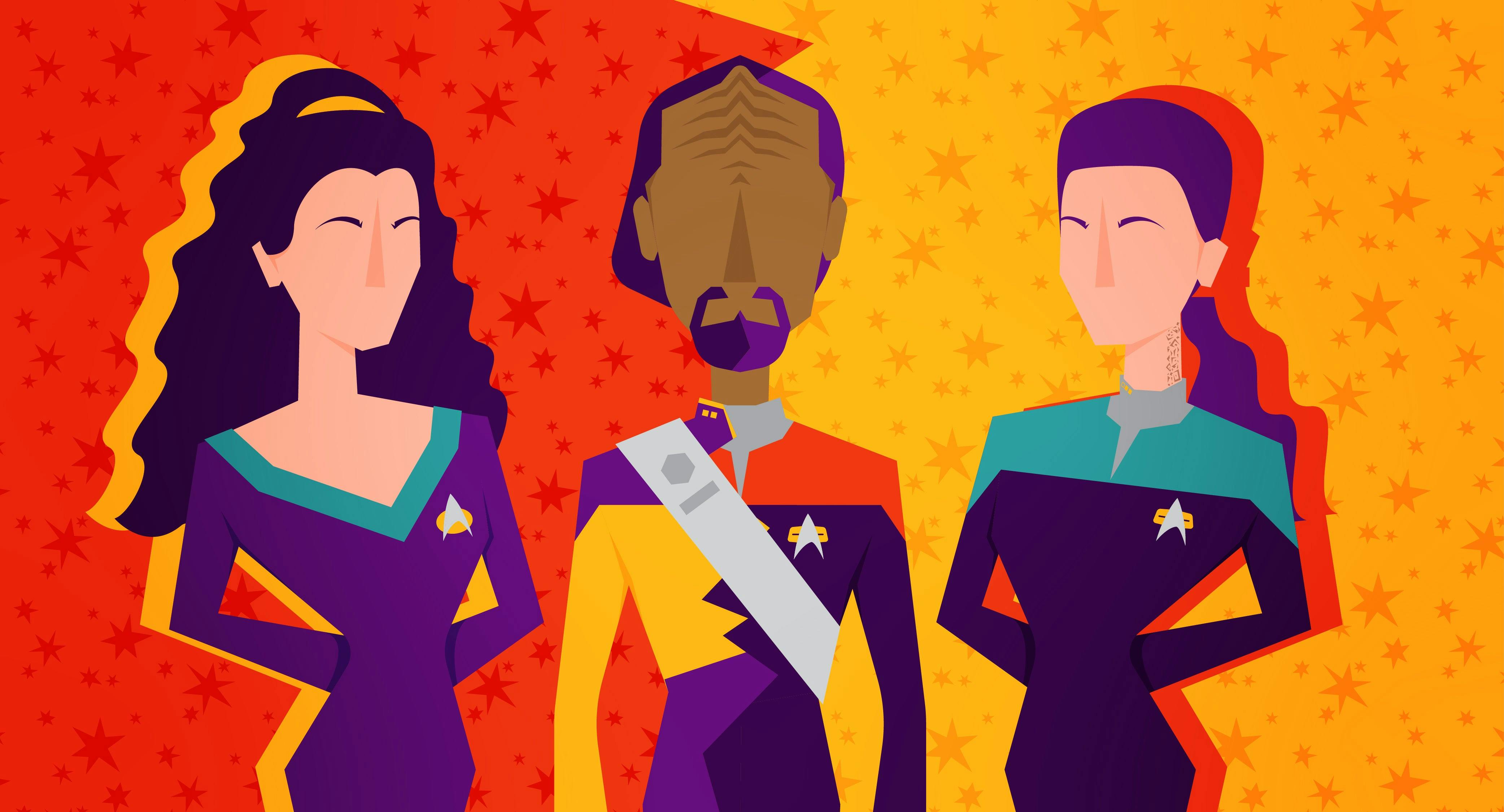
StarTrek.com
In the Star Trek Universe, Klingons are presented as being hyper-masculine, exemplifying all the unhealthy views of “traditional masculinity” in western society. They are highly patriarchal and prideful warriors singularly focused on maintaining a reputation of strength. Any signs of emotions that aren’t antagonistic or hostile are considered weak and unbecoming. This mentality permeates to every level of their culture from their dislike of bathing and doctors to the fact that there’s no Klingon word for “jolly.” Chances are that you’d never encounter a Klingon ship willing to ask for directions either.
When we first meet Worf he is the epitome of toxic masculinity. Born on the Klingon homeworld but raised by humans, he is insecure about his heritage and constantly feels the need to prove his “Klingon-ness.” This insecurity manifests as constant suggestions to Captain Picard to be more aggressive in his actions and an initially detached demeanor with his crewmates.
His first significant romance is with K'Ehleyr , a half-Klingon, half-human woman, who similarly feels trapped between two cultures. However, unlike Worf, she rebuffs Klingon values and embraces her human side. She even refuses multiple proposals from him that she believes are made to appease his arcane concepts of obligation. Although she is eventually killed by Duras — a political figure in the Klingon empire — she secretly gives birth to their son Alexander.
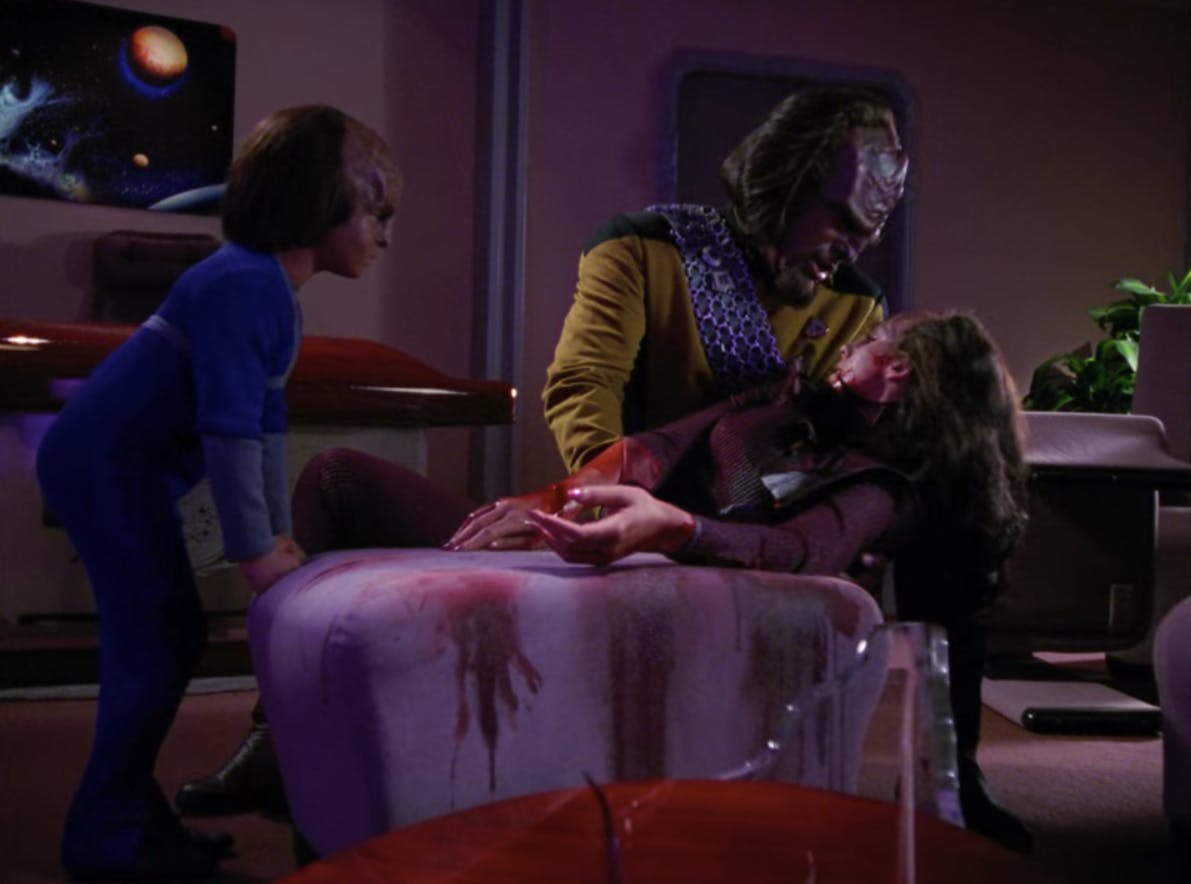
Her devastating demise shows Worf the consequences of holding on too rigidly to concepts of “honor.” The reason they had ultimately not wed was because Worf was disgraced in the Klingon culture, and he did not want to bring shame to his son. Now, suddenly a single parent, he is forced to question his views on manhood while raising a young boy.
It is his son's presence on the ship that becomes the catalyst for his relationship with Counselor Deanna Troi . Since Alexander wasn’t brought up with Klingon values, she acts as a mediator and surrogate mother for the two. Worf eventually asks her to formalize this arrangement and become Alexander’s “Sol-Chim,” or godmother. While helping raise his son, she encourages him to be more vulnerable and consider the effects of his egocentric actions on others.
Her influence is best exemplified in the Season 5 episode “Ethics'' where Worf is thought to be permanently paralyzed after an accident. He decides it would be preferential to be put to death than continue to live in this new reality. Deanna is the one who pushes him to reevaluate his priorities and consider his son’s well-being above his own selfish pride.

At the end of the episode, after a miracle treatment of course, we see Worf acquiesce to letting Alexander assist him when he struggles with his physical therapy. It’s through Deanna's guidance that he comes to realize there's more strength in dealing with your emotions than in suppressing them and lashing out. Although their connection is further explored in “Parallels,” where the two are married in an alternate timeline, they pursue a short-lived relationship which ends off-screen.
Finally, we come to Jadzia Dax , who can arguably be called the love of his life. Unlike his previous romantic partners, Jadzia did something that no one from his past truly did. Instead of pushing him to accept the morality of human culture, she embraced Klingon heritage. Although, during much of the show, most Klingons are focused on maintaining their image instead of the ethical demands of honor; Jadzia saw the nobility in their traditions. Her previous host, Curzon Dax, was a top Ambassador during numerous negotiations with Kllingons and had earned the respect of their people. As a Trill, Jadzia inherited his memories and admiration for their heritage. We see her commitment to this in the episode “Blood Oath,” when she follows through with a promise Curzon made to a group of Klingons. She does this not out of obligation, but because she genuinely feels it is right and honorable. This way, much like Worf, although she is “othered” among the Klingons, she is still immersed in its culture.
When Worf arrives on DS9, Jadzia welcomes him with advice, companionship, and Klingon Opera. She also earns his respect by continuously challenging his more sexist beliefs. When he mistakenly assumes her Klingon training Holo-program belonged to her previous male host, she assures him it’s hers. When she challenges him to a bat’leth match in “The Way of the Warrior” and notices he’s holding back, she tells him not to. Even in their courtship, it’s Jadzia who makes the first move and is a constant source of support in Klingon matters. When Worf is temporarily given command of a Klingon bird-of-prey in “Soldiers of the Empire,” she joins him after noticing the tense dynamic of the crew and expertly handles those on board.Through their relationship, we see Worf evolve; and once they decide to get married, he is the one planning their dream wedding for months beforehand. This illustrates his sense of security both in their relationship and his masculinity to take on something usually considered to be the bride’s prerogative.
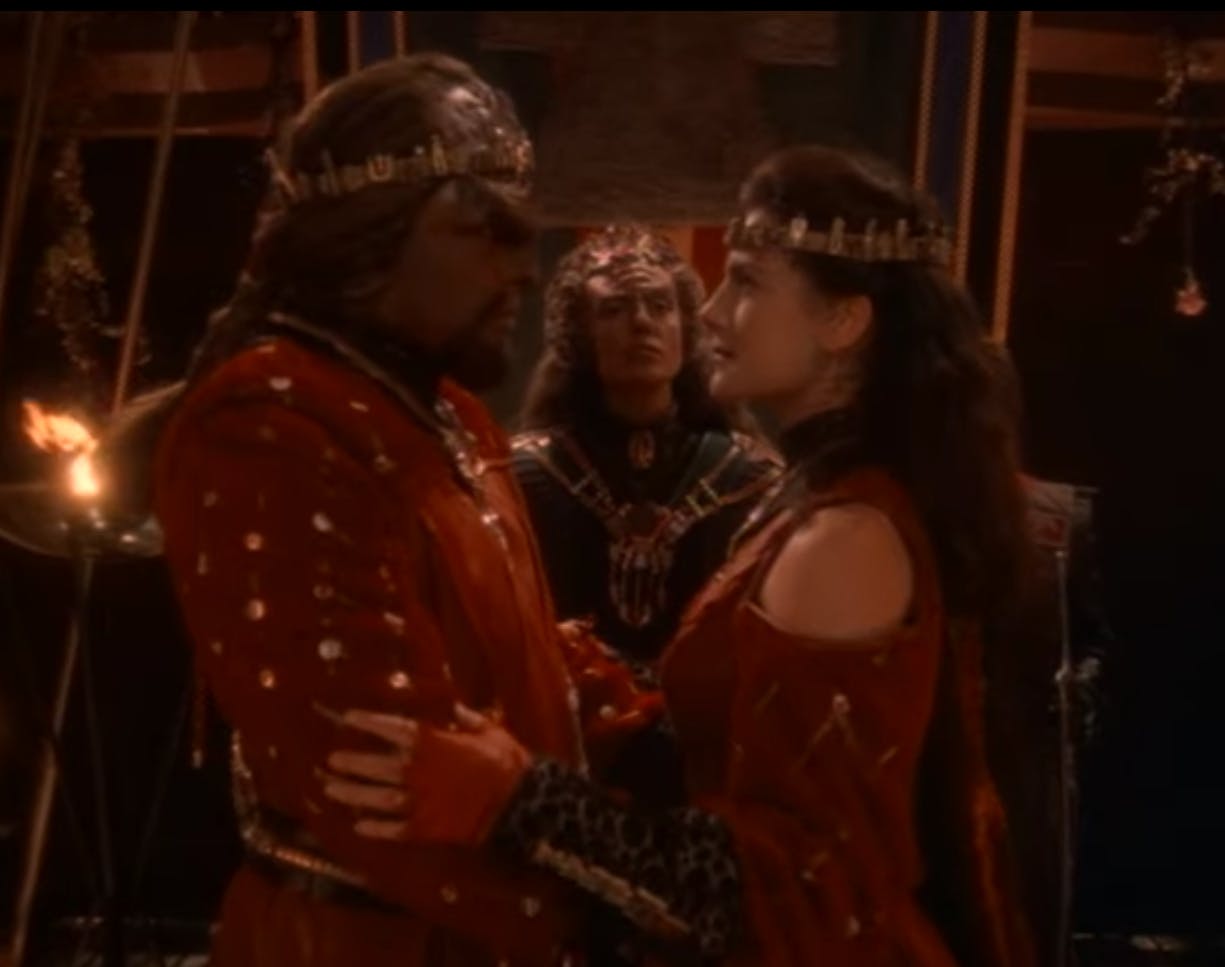
We also see a shift in his understanding of “honor” while with Jadzia. On a mission, where she is severely wounded, he has to make a choice between saving his wife or completing his duty. Instead of abandoning her and pursuing “victory in battle” — which is certainly the Klingon way — he decides to rescue her instead. This results in a blemish on his record, a blow to the war, and a loss at the chance of ever getting a command position. In that moment, he decided that sometimes the most honorable thing to do is perhaps not what a traditional Klingon might do. Unfortunately, as Jadzia and Worf were planning on starting a family, she was suddenly attacked and died just the same. But their relationship left him changed for the better.
Worf’s growth throughout the series explores questions of honor, pride and what it means to “be a man.” While initially conforming to the mandates of masculinity prescribed by Klingon culture, he slowly evolves his beliefs through the emotional connections he makes with others. Ultimately, these relationships allow him to reexamine his values and create his own understanding of honor. It is the love he receives, and in turn, gives to others that transforms his beliefs and we could all learn a lesson through his experiences.
This article was originally published on May 14, 2021.
Zoe Malik (she/her) is a lifelong Star Trek fan and writer based in New York. She is currently the News Producer at Full Frontal with Samantha Bee and occasional producer/writer for YouTube channels including TheTryGuys. Before pursuing her passion for writing she was the Science Researcher Coordinator at NYU Langone Medical Center.
Stay tuned to StarTrek.com for more details! And be sure to follow @StarTrek on Facebook , Twitter , and Instagram .
Get Updates By Email

Klingon (TNG) Female Engineering Bridge Officer
- VisualEditor
- View history
The Klingon (TNG) Female Engineering Bridge Officer is a Klingon Engineering officer available for Klingon Recruit characters for completing the 50 Ambush Kills recruitment task. Her appearance is not randomized, and she comes wearing a 2409 Klingon uniform, but she can be customized as any other Klingon bridge officer. Her name is randomized upon commission.
Traits [ | ]
Abilities [ | ]
Space [ | ].
Ground [ | ]
Items [ | ]
Notes [ | ]
- Using an Elite Bridge Officer Training Token on her will upgrade her Basic Space Warfare Specialist trait to Superior Space Warfare trait.
- Klingon recruits that already claimed her at Rare quality must dismiss and reclaim her to get the upgraded trait.
See also [ | ]
- Special bridge officer
- 2 Playable starship
- 3 List of canon starships

Star Trek: Discovery Season 5 Episode 6 Ending Explained
WARNING: Contains SPOILERS for Star Trek: Discovery, season 5, episode 6, "Whistlespeak".
- Burnham's decision to break the Prime Directive saved Tilly and the Halem'nites from certain death.
- Tilly's struggles with Starfleet Academy students hint at a future storyline for Star Trek: Starfleet Academy.
- Culber's spiritual awakening challenges Star Trek's rationalism, leading to a deeper exploration of his character.
By the end of Star Trek: Discovery season 5, episode 6, "Whistlespeak", Captain Michael Burnham (Sonequa Martin-Green) and the crew are one step closer to the Progenitors' technology, following a mission to a pre-warp society that risked the life of Lt. Sylvia Tilly (Mary Wiseman). After last week's big revelations about the Mirror Universe, Moll (Eve Harlow), L'ak (Elias Toufexis), and the Breen Imperium, "Whistlespeak", written by Kenneth Lin and Brandon Schultz, and directed by Chris Byrne, is a more traditional Star Trek adventure. Seeking the next clue on the planet Halem'no, Burnham and Tilly join the Journey of the Mother Compeer.
This religious pilgrimage takes the form of a race to prove devotion to Halem'no's gods, in the hope of making it rain again. However, this religious pilgrimage has life-threatening consequences for Tilly , providing Burnham with a dilemma over whether she breaks Star Trek 's Prime Directive to save her friend. Elsewhere, on the USS Discovery, Ensign Adira Tal (Blu del Barrio) is struggling to settle into their new role as science officer on the bridge, while Dr. Hugh Culber (Wilson Cruz) gets closer to coming to terms with his spiritual awakening, courtesy of some wise words from Cleveland Booker (David Ajala).
Star Trek: Discovery Season 5 Returning Cast & New Character Guide
Captain burnham broke the prime directive to save tilly, the halem'nites and tilly would have died without burnham..
Believing that the next clue to the Progenitors' treasure was hidden in the High Summit, a weather tower disguised as a mountain, Burnham and Tilly joined the pilgrimage in the hope of making it inside. However, it quickly transpired that once inside the tower, there was no way out. Designed by Denobulan scientist Hitoroshi Kreel , the towers were designed to protect the Halem'nites from the punishing dust storms that take place on their planet. Tilly and young initiate Ravah (June Laporte) became trapped inside the vacuum chamber, meaning that they would suffocate to death unless they were rescued.
The Denobulans were introduced in Star Trek: Enterprise via the Enterprise NX-01's Denobulan Dr. Phlox (John Billingsley).
Discovery was unable to beam Tilly and Ravah out of the weather tower due to the walls being made of tritanium, making it impossible to get a transporter lock . Which is why Burnham made the difficult decision break the Prime Directive by beaming into the weather tower's control room to reveal the truth to Ohvaz (Alfredo Narciso). Burnham was right to break the Prime Directive , because the Denobulan weather towers were failing, and in drastic need of repair. Without Burnham's intervention, Tilly and Ravah would have died for no reason, and the Halem'nites would have eventually been driven to extinction .
While it's definitely a breach of the Prime Directive, Burnham is still very careful not to destroy Ohvaz's beliefs , telling him that " Nothing we have shown you means gods don't exist ". Indeed, Burnham's quest for life itself is proof of some higher power in the Star Trek universe . While Commander Rayner (Callum Keith Rennie), Tilly, and Burnham all lament the inevitable ramifications, it seems likely that Dr. Kovich (David Cronenberg) will brush off this breach of the Prime Directive in favor of Discovery's Red Directive mission .
There is a Prime Directive exception to allow repairs to existing "contamination" as long as it doesn't interfere with the natural growth of the populace, which is effectively what Burnham did on Halem'no.
Tilly's Away Mission Sets Up Star Trek: Starfleet Academy
Starfleet academy is failing its new students..
Star Trek: Discovery season 5, episode 6, "Whistlespeak" appears to set up Star Trek: Starfleet Academy by revealing more about Tilly's struggles to get through to her students . Discussing her new career with Burnham, Tilly reveals that one of her students wants to quit the Academy to take a position aboard a cargo freighter. Later, when they meet Ravah, Tilly notes the similarities between the young woman keen to prove herself to her gods and the Starfleet Academy cadet who wants to get out into the stars as soon as possible.
Star Trek: Discovery Proves Starfleet Academy Show Doesnt Make Sense Without Tilly
Tilly and Ravah's instant connection is a welcome reminder of why Tilly's such a good fit for Starfleet Academy . Tilly's empathy for Ravah, and the gut-wrenching guilt when she realizes that she's signed her death warrant demonstrates the huge responsibility involved in training new Starfleet officers. Confiding in Michael, Tilly reveals that she thinks Starfleet Academy is failing their students, perhaps focusing more on the theoretical than the practical. Tilly's final mission on the USS Discovery, and interactions with characters like Ravah could help her to reform the institution when she returns to Starfleet Academy.
The Meaning of Denobulan's Progenitors Clue Explained
"...we need to be so careful.".
In Star Trek: Discovery season 5, episode 5 , "Mirrors", Burnham and Book realized that each of the clues to the Progenitors' treasure contained important lessons. For example, the clue hidden on Trill, in the heart of an Itronok nest, was designed to test whether Book and Burnham valued life-forms different from their own. As with all the previous clues, the one left behind by Denobulan scientist Kreel contains a message, which is discussed by Burnham and Tilly, after they secure it from the dormant fifth weather tower.
It transpires that the cultural impact of the technology installed on Halem'no by the Denobulans was the lesson . When the towers began failing, the Halem'nites began sacrificing themselves to make it rain, something that the Denobulans could never have predicted. It's a reminder to Burnham and Tilly that when they eventually find the Progenitors' technology they have to be very careful with how they use it. The fifth and final clue, located in the fifth weather tower, is written in Betazoid text, left behind by the fifth and final scientist, Marina Derex.
Dr. Culber Is Coming To Terms With His Experience On Trill
Culber's had a "thrilling" spiritual awakening..
Dr. Culber's spiritual awakening has been one of the most interesting storylines in Star Trek: Discovery season 5, as it challenges the franchise's stance on religion . The clash between Star Trek 's rationalism and Culber's spiritualism is exemplified by his discussions with a hologram of his Abuela (Maria del Mar), a spiritual woman who raised Hugh to be a man of science. However, after spending the episode trying to find a scientific explanation, Culber instead realizes that there isn't one , and that his mind is instead opened up to new possibilities and something larger than himself.
At the end of Star Trek: Discovery season 5, episode 6, Dr. Culber discusses his new awakening with Book, who acknowledges that it " sounds kind of wonderful ". Book advises Culber not to be so concerned that his husband, Commander Paul Stamets (Anthony Rapp) doesn't quite understand Hugh's new perspective . Reflecting on Culber's situation as a Kwejian, Book helps Hugh come to terms with it by sharing an observation of human relationships, and the obsession with sharing a personal passion with a partner:
"It's an odd quirk, really, this human tendency to consider something less meaningful if it's just for yourself."
Wilson Cruz Killed It Playing Star Trek: Discovery's Trill
Will book and michael get back together in star trek: discovery season 5, "one answer at a time, doc".
To return the favor, Dr. Culber tries to get Book to open up about his break-up with Michael at the end of Star Trek: Discovery season 4 . It's been clear throughout Discovery season 5 that Book and Burnham still have feelings for one another, but they're yet to act upon them . Michael got a reminder of how happy they were in "Face the Strange" when she time traveled back to an earlier point in their relationship. In "Mirrors", their relationship was a reflection of that between Moll and L'ak, and there was a strong sense of Burnham and Book still being a great team.
Dr. Culber quizzes Book about Burnham at the end of Star Trek: Discovery season 5, episode 6, seeing through Booker's front. Asked whether he thinks he can get back what he once had with Michael, Book simply replied " One question at a time, Doc ", proving that affairs of the heart can be even more complex than the search for the Progenitors' treasure. As Book is still determined to get through to Moll after the events of "Mirrors", his "sister" could still provide a major stumbling block for a romantic reunion between Burnham and Booker in Discovery season 5.
Discovery Is Taking A Detour To Deal With Moll And L'ak
The uss locherer just found moll and l'ak..
At the start of Star Trek: Discovery season 5, episode 6, "Whistlespeak", Burnham is ordered by Dr. Kovich to forget about Moll and L'ak and focus on the next clue. By the end of the episode, Federation Headquarters informs the USS Discovery that Moll and L'ak have been located by the USS Locherer . This feels suspicious given Kovich's insistence that Burnham focus on her Red Directive mission and forget all about tracking Moll and L'ak. It remains to be seen if the USS Discovery is about to enter a trap or instead engage in another desperate attempt to bring Moll and L'ak on side.
T he title of Star Trek: Discovery season 5, episode 7, "Erigah", is a reference to the Breen blood bounty placed on Moll and L'ak by Primarch Ruhn (Tony Nappo) . It's likely, therefore, that the translation of the Betazoid clue will be taking a backseat in the next episode, as Burnham and the crew reckon with the ramifications of a Breen blood bounty. As the Discovery crew is so close to the finish line with the Progenitors' treasure there could be no worse time to engage the Breen as Star Trek: Discovery season 5 continues.
Star Trek: Discovery season 5 streams Thursdays on Paramount+.
Star Trek: Discovery
Star Trek: Discovery is an entry in the legendary Sci-Fi franchise, set ten years before the original Star Trek series events. The show centers around Commander Michael Burnham, assigned to the USS Discovery, where the crew attempts to prevent a Klingon war while traveling through the vast reaches of space.
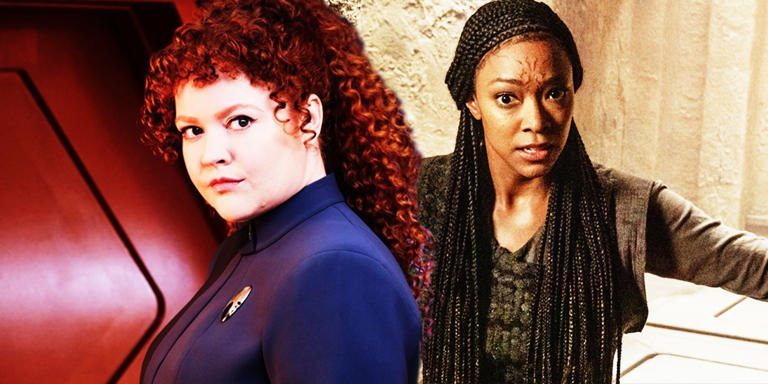
- The Original Series
- The Animated Series
- The Next Generation
- Deep Space Nine
- Strange New Worlds
- Lower Decks
- Star Trek Movies
- TrekCore on Twitter
- TrekCore on Facebook

…and of course, this full-cast photo was released by the streamer earlier this year.
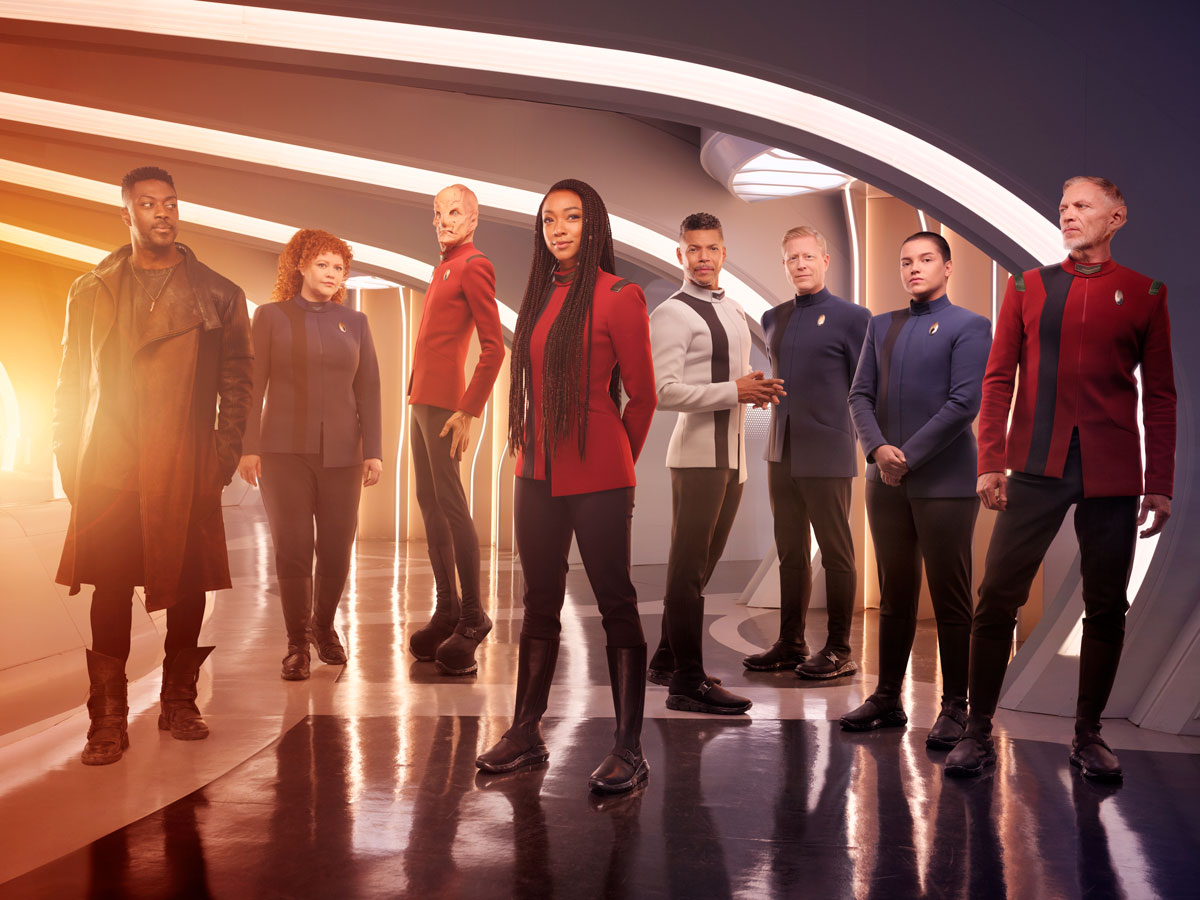
The final season of Star Trek: Discovery runs through May 30 on Paramount+.
Star Trek: Discovery Season 5 continues on Paramount+ May 2 with “Whistlespeak,” followed the next day on SkyShowtime in other regions.
- Cast Photos
- DSC Season 5
- Star Trek: Discovery
Related Stories
Star trek: discovery review — “whistlespeak”, pinewood toronto dedicates soundstage to the star trek franchise, new star trek: discovery photos — “whistlespeak”, search news archives, new & upcoming releases, featured stories, lost-for-decades original star trek uss enterprise model returned to roddenberry family, star trek: lower decks cancelled; strange new worlds renewed for season 4, our star trek: discovery season 5 spoiler-free review.
TrekCore.com is not endorsed, sponsored or affiliated with Paramount, CBS Studios, or the Star Trek franchise. All Star Trek images, trademarks and logos are owned by CBS Studios Inc. and/or Paramount. All original TrekCore.com content and the WeeklyTrek podcast (c) 2024 Trapezoid Media, LLC. · Terms & Conditions

- View history
Mara was the Klingon wife of Captain Kang and science officer aboard his battle cruiser . ( TOS : " Day of the Dove ")
As a product of 22nd century genetic engineering , Mara was descended from Klingons affected with the Klingon augment virus created in 2154 . ( ENT : " Divergence ")
In 2268 , Mara was part of the Klingon crew and Starfleet crewmembers aboard the USS Enterprise that while under the mind control of an unknown alien entity were fighting a no win battle. She was very worried that she would be violated by the Starfleet crew. She assisted Captain Kirk in negotiating a peaceful end to the conflict by taking him to Kang and supporting Kirk's theory that an alien was controlling both forces. ( TOS : " Day of the Dove ")
Background information [ ]
Mara was played by actress Susan Howard . She was the first featured character to portray a Klingon female in the series. The script described her as "an especially striking woman" as well as possessing "icy intelligence."
Although the reference was never mentioned on screen , it is very possible that Mara was the mother of Dax, son of Kang , from DS9 : " Blood Oath ". Mara was not mentioned in that episode and it is unknown if she was still alive at the time of her husband's death in the episode, which took place more than a century after their last appearance.
External link [ ]
- Mara at Memory Beta , the wiki for licensed Star Trek works
- 2 ISS Enterprise (NCC-1701)

IMAGES
VIDEO
COMMENTS
Star Trek V: The Final Frontier (1989) cast and crew credits, including actors, actresses, directors, writers and more. ... Klingon and Vulcan prosthetics Paul Harrod ... special makeup effects: sculptor ... women Ray Phelps ... wardrobe: men (as Raymond A. Phelps)
B'Etor was a female Klingon officer of the 24th century Klingon Empire and member of the House of Duras. She was the younger of the two Duras sisters, herself and Lursa, sister of Duras and daughter of Ja'rod. Through Duras, she had a nephew, Toral. As sister to Lursa, B'Etor was one of the Duras sisters responsible for the start of the Klingon Civil War in early-2368. She was the younger ...
Shamelessly scheming, cheating, and plotting, Lursa, with her snarling power hungriness, and B'Etor, with her unabashed use of her sexuality as a weapon, embody a rejection of what a Klingon woman should be. It makes them villains, sure, but it also frees them from the constraints of their society. "Firstborn". StarTrek.com.
Klingon patrol officers. By 2259 in the alternate reality, after Starfleet's first contact with the Empire, the Klingons had conquered and occupied two planets known to the Federation and fired on Starfleet ships half a dozen times. Tensions between the two powers were high and an all-out war was considered inevitable. During that year, before surrendering to the Federation, Khan Noonien Singh ...
She played four characters on various Star Trek series: a Vulcan, Doctor Selar, in "The Schizoid Man" (Star Trek: The Next Generation); half-Klingon, half-human Ambassador K'Ehleyr in "The Emissary" (Star Trek: The Next Generation) and "Reunion" (Star Trek: The Next Generation); the Lady Q in "The Q and the Grey" (Star Trek: Voyager); and an ...
Star Trek V: The Final Frontier: Directed by William Shatner. With William Shatner, Leonard Nimoy, DeForest Kelley, James Doohan. Captain Kirk and his crew must deal with Mr. Spock's long-lost half-brother who hijacks the Enterprise for an obsessive search for God at the center of the galaxy.
Mary Chieffo. Actress: Star Trek: Discovery. Mary Chieffo (she/her) is a queer actor/producer known internationally as the Klingon Commander turned Chancellor L'Rell on the Paramount+ series Star Trek: Discovery, returning as her iconic character for the highly popular Star Trek Online. After playing numerous Shakespeare roles including the titular characters in King Lear and Macbeth, Chieffo ...
Star Trek V: The Final Frontier is a 1989 American science fiction film directed by William Shatner and based on the television series Star Trek created by Gene Roddenberry.It is the fifth installment in the Star Trek film series, and takes place shortly after the events of Star Trek IV: The Voyage Home (1986). Its plot follows the crew of the USS Enterprise-A as they confront renegade Vulcan ...
Star Trek's depiction of Klingons has evolved several times, coming to embody a culture based on honor and prowess in battle. Yet one of the women at the center of Klingon history, Lukara, has yet to be depicted in any of the series or movies. When contrasted with the Klingon women who have appeared in Trek, the lack of Lukara is very striking.
The origins of the Klingons explained. Klingons are a technologically advanced warrior species that come from the planet Qo'noS in the Beta Quadrant. Best known for their fierceness and respect for honor, the Klingon Empire is one of the most formidable and powerful forces in the galaxy and carries a brutal reputation.
Design Conception Two Klingon men and a Klingon woman as they appear in the Star Trek: The Original Series episode "Day of the Dove".The bronzed skin, facial hair, lack of ridged foreheads, and simple costumes are typical of The Original Series.. The Klingons were created by screenwriter Gene L. Coon, and first appeared in the Star Trek episode "Errand of Mercy" (1967).
Lursa was a female Klingon officer of the 24th century Klingon Empire and member of the House of Duras. She was the elder of the two Duras sisters, herself and B'Etor, sister of Duras and daughter of Ja'rod. Through Duras, she had a nephew, Toral. She was the mastermind behind her family's fight to head the Klingon Empire. Together with B'Etor, she was responsible for the beginning of the ...
The Klingons first appeared in Star Trek: The Original Series season 1, episode 26, "Errand of Mercy".Actor John Collicos, who played Kor in the episode, was the first TOS Klingon, and is largely responsible for their look, and the depiction of them as conquerors.Collicos took inspiration from Genghis Khan, which made the Klingons a more universal foe than the communist analogs they were ...
In the Klingon belief system, the body after death is an empty shell. The soul of a fallen Klingon goes to one of two places. If they lived an honorable life and fell in battle, they go to Sto ...
Nevertheless, some women, like Lursa and B'Etor on TNG, not only held power in their house but shaped the Empire with their efforts. Those with ties to humanity, such as Worf's mate, K'Ehlor, and Lt. B'Elanna Torres on Voyager, escaped prescribed Klingon gender roles outside of the Empire. Of course, the Klingons may have been more ...
Jeff Byrd's love for Star Trek began at an early age with his family surrounding their television set together. "Back in the day, when I was just a little boy, my parents used to have us watch Star Trek because of Uhura," recalls the director. "She was the only Black woman on television at the time. We would all gather around the TV to ...
Mary Elizabeth Chieffo (born November 7, 1992) is an American actress known for portraying the Klingon L'Rell on the television series Star Trek: Discovery. ... Chieffo came out publicly as a lesbian on the red carpet prior to the Star Trek Day event held September 8, 2021, at the Skirball Cultural Center in Los Angeles, California.
The Emissary: Directed by Cliff Bole. With Patrick Stewart, Jonathan Frakes, LeVar Burton, Michael Dorn. The Enterprise addresses the emergency of an old Klingon ship coming out of stasis and ready to fight the Federation. A half-Human/half Klingon emissary arrives to help, who once knew Worf intimately.
Grilka was a Klingon woman of the House of Grilka in the 24th century Klingon Empire. She was from the Mekro'vak region on Qo'noS. She was married to Kozak, though was widowed. Her most trusted adviser was Tumek. After Kozak died in Quark's in early 2371, Quark took credit for killing her husband, even though Kozak actually fell onto his own knife. She forced Quark to marry her so she could ...
His first significant romance is with K'Ehleyr, a half-Klingon, half-human woman, who similarly feels trapped between two cultures. However, unlike Worf, she rebuffs Klingon values and embraces her human side. She even refuses multiple proposals from him that she believes are made to appease his arcane concepts of obligation.
The Klingon (TNG) Female Engineering Bridge Officer is a Klingon Engineering officer available for Klingon Recruit characters for completing the 50 Ambush Kills recruitment task. Her appearance is not randomized, and she comes wearing a 2409 Klingon uniform, but she can be customized as any other Klingon bridge officer. Her name is randomized upon commission. Basic Space Warfare Specialist ...
Star Trek: 5 Things You Didnt Know About Sulu ... Kirk is suspicious about the Klingon involvement, ... Nyota Uhura is one amazing character who paved the way for women of color in television.
Valkris was a female Klingon operative in the 23rd century, who was romantically involved with Commander Kruge. In 2285, Valkris undertook a mission for Kruge to obtain information on the Federation technology known as "the Genesis Device." Hiring a merchant vessel to facilitate her mission, Valkris made contact with Kruge and supplied him with the data. When Kruge learned, however, that ...
Culber's spiritual awakening challenges Star Trek's rationalism, leading to a deeper exploration of his character. By the end of Star Trek: Discovery season 5, episode 6, "Whistlespeak", Captain ...
It took a while, but today Paramount+ has finally released official cast photography from the final season of Star Trek: Discovery this morning! In today's new photo drop, you can see the new portraits of the entire cast: Captain Michael Burnham (Sonequa Martin-Green), Saru (Doug Jones), Hugh Culber (Wilson Cruz), Paul Stamets (Anthony Rapp), Sylvia Tilly (Mary Wiseman), Adira Tal (Blu del ...
Mara was the Klingon wife of Captain Kang and science officer aboard his battle cruiser.(TOS: "Day of the Dove") As a product of 22nd century genetic engineering, Mara was descended from Klingons affected with the Klingon augment virus created in 2154.(ENT: "Divergence") In 2268, Mara was part of the Klingon crew and Starfleet crewmembers aboard the USS Enterprise that while under the mind ...